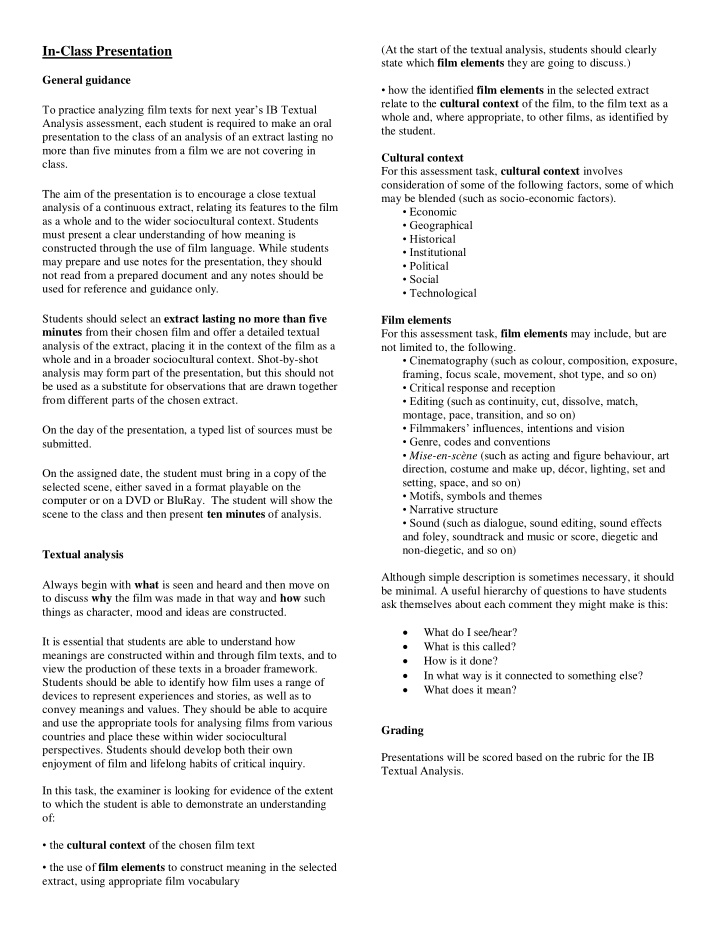



In-Class Presentation (At the start of the textual analysis, students should clearly state which film elements they are going to discuss.) General guidance • how the identified film elements in the selected extract relate to the cultural context of the film, to the film text as a To practice analyzing film texts for next year’s IB Textual whole and, where appropriate, to other films, as identified by Analysis assessment, each student is required to make an oral the student. presentation to the class of an analysis of an extract lasting no more than five minutes from a film we are not covering in Cultural context class. For this assessment task, cultural context involves consideration of some of the following factors, some of which The aim of the presentation is to encourage a close textual may be blended (such as socio-economic factors). analysis of a continuous extract, relating its features to the film • Economic as a whole and to the wider sociocultural context. Students • Geographical must present a clear understanding of how meaning is • Historical constructed through the use of film language. While students • Institutional may prepare and use notes for the presentation, they should • Political not read from a prepared document and any notes should be • Social used for reference and guidance only. • Technological Students should select an extract lasting no more than five Film elements minutes from their chosen film and offer a detailed textual For this assessment task, film elements may include, but are analysis of the extract, placing it in the context of the film as a not limited to, the following. • Cinematogr aphy (such as colour, composition, exposure, whole and in a broader sociocultural context. Shot-by-shot analysis may form part of the presentation, but this should not framing, focus scale, movement, shot type, and so on) • Critical response and reception be used as a substitute for observations that are drawn together • Editing (such as continuity, cut, dissolve, match, from different parts of the chosen extract. montage, pace, transition, and so on) • Filmmakers’ influences, intentions and vision On the day of the presentation, a typed list of sources must be • Genre, codes and conventions submitted. • Mise-en-scène (such as acting and figure behaviour, art direction, costume and make up, décor, lighting, set and On the assigned date, the student must bring in a copy of the setting, space, and so on) selected scene, either saved in a format playable on the • Motifs, symbols and themes computer or on a DVD or BluRay. The student will show the • Narrative structure scene to the class and then present ten minutes of analysis. • Sound (such as dialogue, sound editing, sound effects and foley, soundtrack and music or score, diegetic and non-diegetic, and so on) Textual analysis Although simple description is sometimes necessary, it should Always begin with what is seen and heard and then move on be minimal. A useful hierarchy of questions to have students to discuss why the film was made in that way and how such ask themselves about each comment they might make is this: things as character, mood and ideas are constructed. • What do I see/hear? It is essential that students are able to understand how • What is this called? meanings are constructed within and through film texts, and to • How is it done? view the production of these texts in a broader framework. • In what way is it connected to something else? Students should be able to identify how film uses a range of • What does it mean? devices to represent experiences and stories, as well as to convey meanings and values. They should be able to acquire and use the appropriate tools for analysing films from various Grading countries and place these within wider sociocultural perspectives. Students should develop both their own Presentations will be scored based on the rubric for the IB enjoyment of film and lifelong habits of critical inquiry. Textual Analysis. In this task, the examiner is looking for evidence of the extent to which the student is able to demonstrate an understanding of: • the cultural context of the chosen film text • the use of film elements to construct meaning in the selected extract, using appropriate film vocabulary
Recommend
More recommend